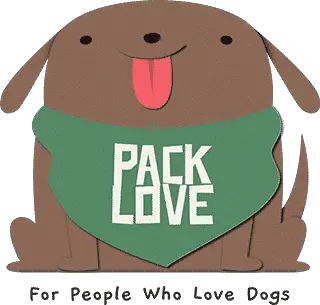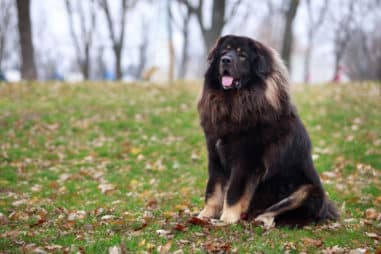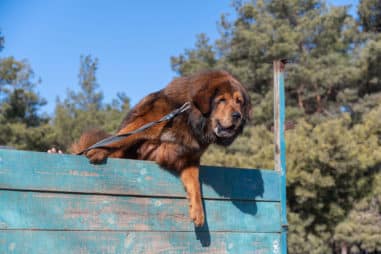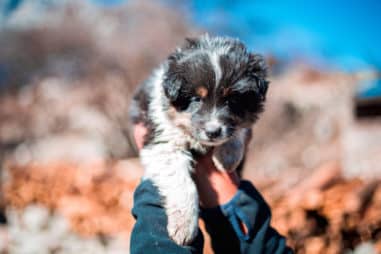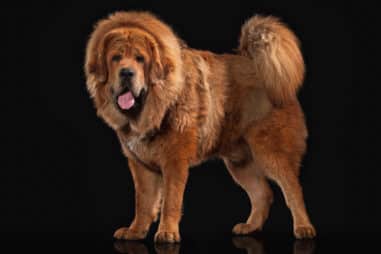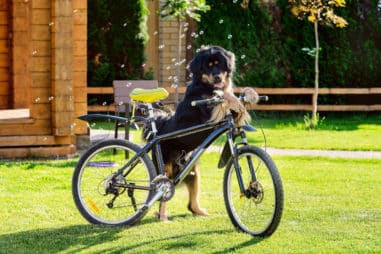Grooming is not a challenge when an owner knows what to do. Having a grooming kit ready is going to be useful. But if you’re inexperienced, there are people that you can contact to take care of things.
Despite being double-coated dogs, Tibetan Mastiffs don’t produce a lot of odor. They may not be hypoallergenic, but the amount of shedding is low. You can avoid issues by making sure that your dog is in top shape.
Are Tibetan Mastiffs Easy or Hard to Take Care of?
Taking care of Tibetan Mastiffs is both easy and hard. Their bodies know how to adapt to different climates. The easy part is they don’t shed too often and they don’t produce a nasty smell.
The hard part may come in the form of stubbornness, and that’s why training is important. A dog’s unwillingness to bathe or get brushed is a pain. But they are necessary to keep them healthy and squeaky clean.
Do You Groom Tibetan Mastiffs?
Every dog needs some form of a grooming routine. Though not notorious for shedding and stinking, Tibetan Mastiffs need grooming too. The routine should include brushing and bathing.
It’s actually up to the owner how many times a dog will get a bath. A weekly bath will keep a Tibetan Mastiff clean. They can last up to 6 weeks without bathing, but weekly or twice a month bathing is preferable.
Bathing is done to regulate the oil production of the skin underneath their coats. Like humans, too much oil can cause itching and even stinking. Trimming their fur once in a while is a nice addition.
Are Tibetan Mastiffs Easy to Groom?
Tibetan Mastiffs are easy to groom as long as they’re cooperative. Their minimal shedding and the lack of strong odors make grooming easier. The availability of necessary tools and products plays a role in this routine.
Sometimes they can’t help but let their stubborn nature show. But as a dog parent, you have to put up with it once in a while. If you have the resources, a groomer will get the job done for you.
What Kind of Grooming Does a Tibetan Mastiff Need?
Bathing and brushing are basic parts of grooming. This is to keep the dirt and dead hair away. With their fairly thick fur, Tibetan Mastiffs can also benefit from trimming.
Their oral health is also important. Skipping oral hygiene can lead to infections and diseases. The foul smell coming from a dog’s mouth is a possible result of poor hygiene.
If you’re not sure about what products to use, talk to an expert. A groomer or vet can guide you in choosing the right stuff for your dog. Safety should always come first.
How Often Do You Need to Groom a Tibetan Mastiff?
It is preferable to bathe your Tibetan Mastiff weekly or twice a month. Brushing or combing the coat should be done regularly, especially during the seasonal shed. A little trimming can be beneficial.
After a bath, use a blow dryer to make the coat dry quickly. Leaving a dog’s fur wet for a long time can pose the risk of having hypothermia. Keep this in mind when bathing your Tibetan Mastiff.
When Should I Start Grooming My Tibetan Mastiff?
Tibetan Mastiff puppies will get by without grooming within the first few months. Because they are more sensitive to products and the environment, a bath or grooming procedure should be done on a puppy who’s 4 to 8 weeks old.
During the first year, one to four baths are more than enough for a Tibetan Mastiff. If they’re 12 to 18 months old, the number of baths can be increased gradually.
How to Groom a Tibetan Mastiff
Grooming should get more attention during the spring season. The grooming kit must-haves are grooming shears, brush, comb, and a clipper. For bathing, you’ll need towels, soap/shampoo, and a blow dryer.
When his fur begins to shed, use a comb or brush to get rid of excess hair. Comb or brush his coat gently and make the strokes go in a single direction. Clean up the fallen hair to avoid allergens.
Bathing your Tibetan Mastiff is not so different from other dogs. Use the safe and right products for him, and avoid water from getting into the ears. Since he’s double-coated, a blow dryer will speed up the drying of his coat.
You can trim his fur if you’re not too concerned about being stylish. If you’re about to give your Tibetan Mastiff a trim, do it in a spacious area. Considering their size, using a grooming table is up to you.
Remember to be careful when using sharp objects in grooming. If you’re having doubts about grooming at home, take him to a professional groomer.
Some owners take a dog’s oral hygiene for granted. That shouldn’t be the case because there are products suitable for their oral/dental health. Some toothbrushes allow you to insert a finger for better control in teeth cleaning.
How Do You Groom Tibetan Mastiff Ears?
If you want to clean your Tibetan Mastiff’s ears, an ear cleaning solution will do the trick. Just grab some cotton and apply the solution gently to his ears. Sometimes you have to leave the ear cleaning tools to the pros.
The ear cleaning solution will get rid of itch-causing bacteria and excess ear wax. But before buying any products, discuss this with a vet first. Beware of knock-off and unlicensed products in the market.
As they say, anything excessive is bad. Avoid overcleaning your dog’s ears as it can increase the risk of infections. Do it once in a while and you’re good to go.
Do Tibetan Mastiffs Need to Go to the Groomers?
It depends on the owner’s experience and schedule. A busy schedule and inexperience can do more harm than good. This is when groomers step in.
They’re equipped with grooming kits and experience to make your Tibetan Mastiff look sharp and dandy. Groomers are in charge of making dogs look their best. Show dogs are brought to groomers before entering a competition.
If you are not concerned about being stylish, you can do the basic grooming at home. Bathing and brushing will get easier with time.
How Much Does It Cost to Groom a Tibetan Mastiff?
Basic grooming for dogs can cost 30 to 60 USD. This includes bathing, blow-drying, nail trimming, and ear cleaning. Some groomers perform anal gland expression to release excess fluid.
The size of a dog can affect the price of a grooming session. Since Tibetan Mastiffs are big dogs, a higher price for the package may apply.
How Do You Groom a Tibetan Mastiff at Home?
Grooming a double-coated dog such as the Tibetan Mastiff will need a slicker brush. Brushing and combing through the coat helps in the prevention of matting. Because of a Mastiff’s size, grooming must be done in a spacious area.
When it comes to bathing, having a tub at home is a plus. Use a shampoo that is formulated for dogs. If a dog shampoo is not available, baby shampoo is a safe alternative.
You can use an ear cleaning solution to remove excess wax from your dog’s ears. Put the recommended amount on a piece of cotton and gently apply it to affected areas. If you have a grooming kit, use the tools with care.
How Do You Groom a Tibetan Mastiff With Clippers?
A dog clipper is recommended for grooming your Tibetan Mastiff. Because hair clippers for humans may not work well with double-coated dogs. Using clippers can be dangerous if you lack the experience.
You need to have the right blade number for trimming. Don’t use the clippers on a wet coat. Avoid shaving the coat completely because it can cause problems in regulating body temperature.
You can use shears to give your dog some minimal and safer trimming. Leave the clippers to the groomer if you’re not sure how to use them.
Why Does My Tibetan Mastiff Stink?
Tibetan Mastiffs are not known for releasing strong odors. The stench is a possible result of poor hygiene practices. Establishing a good grooming routine will prevent the unpleasant smell.
If the smell is persistent despite grooming, this could be a sign of a health issue. Consult your vet to identify what causes the stench.
How Do I Stop My Tibetan Mastiff From Smelling?
It’s important to give your Tibetan Mastiff proper hygiene to prevent odor. Make sure that you are using the right products. Diet should be on point as well.
The cleanliness of your home is also a big factor. Letting your Tibetan Mastiff play in a nasty place will soil his coat. Give him regular baths and brush his coat to remove loose hair.
Don’t forget to take care of his teeth. The mouth is a breeding ground for harmful bacteria without proper cleansing. Brush his teeth regularly to get rid of food particles that cause odor.
Consult your vet if the stench is still present after all the cleaning you’ve done. This could be an internal thing that needs medical attention.
How Do You Clean a Tibetan Mastiff?
You can clean your Tibetan Mastiff by bathing. Fill the tub with water and dilute the shampoo in it. Using warm water is preferable because it makes the adjustment to the temperature easier.
Prepare a towel to absorb excess water from his coat. A blow dryer will come in handy to speed up the drying process.
Another way of cleaning your dog is by brushing the coat. This is to get rid of dead, loose hair and give way to the growth of new ones. Since he’s double-coated, using a slicker brush is more effective.
Do Tibetan Mastiffs Like Baths?
It’s common among dogs to have some kind of aversion to water. The Tibetan Mastiff is not so different. You’ve probably seen dogs who enjoy the splash of water, but they’re part of the minority.
Dogs don’t necessarily hate baths. They try to avoid bathing out of fear. Running water makes them uncomfortable and they fear drowning in it.
Why Do Some Tibetan Mastiffs Hate Baths?
Tibetan Mastiffs are brave and confident dogs. But the discomfort they feel from the water makes them wary of bathing. Their double-coats become heavier when wet and it makes them uncomfortable.
The climate can also play a role. They may not be fond of bathing during the colder months. They may appreciate some bathing to cool off during the summer heat.
How Often Should a Tibetan Mastiff Be Bathed?
You can bathe them once a week or twice a month in the warmer seasons. They can last 6 weeks without a bath when the temperature is cold. Frequent baths are recommended if your Tibetan Mastiff likes digging dirt.
Can I Bathe My Tibetan Mastiff Once a Week?
Bathing them once a week is ideal. Twice a month is also good given that they don’t have the habit of rolling around grimy surfaces. Getting rid of grime and excess oil helps in making them look and feel good.
Too much bathing can dry their skin and strip away essential oils. Don’t exceed the recommended number of baths per week, because dryness can cause itching and infection.
How to Bathe a Tibetan Mastiff
Having a tub is a big plus when bathing a big dog like the Tibetan Mastiff. All you have to do is dilute shampoo in the tub filled with water. Before you put him in the tub, wet his coat with warm water.
You can use a sponge to spread the bubbly lather evenly. Rub shampoo repeatedly and wait for a few minutes. Rinse the lather with clean water and dry him with a towel or a blow dryer.
If you don’t have a tub, you can use a bucket and a dipper. You can also use waterless shampoo or cleansing wipes.
Why Do My Tibetan Mastiff’s Ears Stink?
Tibetan Mastiffs have floppy ears. This makes them more prone to infections. An ear infection such as Otitis Media can produce an unpleasant odor.
Another reason is the accumulation of earwax. Earwax is a form of protection but excessive production can be a problem too. Regular cleaning without overdoing it is the key to healthy and odorless ears.
How Often Should You Clean Tibetan Mastiff Ears?
Cleaning your Tibetan Mastiff’s ears once a month is good enough. You can also do the cleaning every other week. This is just to prevent infections and overproduction of wax.
Overdoing it will do more harm than good. Weekly cleaning is only recommended for special cases.
How Do I Clean the Inside of My Tibetan Mastiff Ears?
You can buy an ear cleaning solution and douse a piece of cotton with it. Before application, hold the ear flap and apply the solution. Massage the ear base and wipe it with cotton that contains the solution to break up accumulated wax.
Using distilled water mixed with vinegar is a great homemade alternative. The application is the same as the over-the-counter solution, and you shouldn’t overdo it. Wipe the ears dry after application.
Ear cleaning is also included in grooming packages. Groomers can take care of this if you are worried about your ear cleaning skills.
Is It Common for Tibetan Mastiffs to Have Bad Breath?
Bad breath is common among dogs but not normal. This is a result of bacteria build-up inside the mouth. Poor or lack of oral hygiene is the usual cause of the unpleasant smell.
A sweet-smelling dog is not a good sign either. The sweet smell is usually related to diabetes or kidney disease. The breath of a healthy dog should be neutral.
Why Does My Tibetan Mastiff Have Smelly Breath?
The smell of your Tibetan Mastiff’s breath is an indicator of oral and general health. Poor diet and hygiene can lead to foul-smelling breath. Even the sweet-smelling breath can be a cause for concern.
An appointment with your vet is necessary if the smell persists. This might be a symptom of another health issue.
How Can I Help My Tibetan Mastiff With the Bad Breath?
Regular brushing is the first line of defense against bad breath. The ideal frequency is twice daily. This is to prevent bacteria build-up in the gums, teeth, and tongue.
You’ve heard time and time again that prevention is better than cure. As an owner, you should be one step ahead. Get your Tibetan Mastiff checked regularly before issues arise.
Should I Brush My Tibetan Mastiff Teeth?
Brushing your Tibetan Mastiff’s teeth is essential. Skipping this part of grooming is going to hurt your dog in the long run. Neglecting his oral health can lead to infections and other diseases.
Talk to your vet about the right oral care products that will protect your dog’s mouth. Regular brushing is a must to avoid the nasty smell and serious ailments.
How Often Should Tibetan Mastiffs Get Their Teeth Cleaned?
Brushing your Tibetan Mastiff’s teeth twice a day is recommended. Use a toothbrush designed for dogs and some of them can be inserted into a finger. They are softer and smaller than the ones you are using.
How Do I Brush My Tibetan Mastiff Teeth?
Prepare the toothbrush and put some toothpaste on it. Lift the lips to expose the teeth and apply mild pressure and circular motions. You can also brush with horizontal and vertical strokes.
Rinse his mouth with water. You can reward him for cooperating so that he can get used to it in the future. Though it’s a challenge at first, brushing your Tibetan Mastiff’s teeth is essential.
What Should Tibetan Mastiff Nails Look Like?
A dog’s nail is oval. The ideal length should be somewhere in the middle. It should be visible enough to extend beyond the paw but not too long that it’s scratching the floor.
When the nails are too short, your Tibetan Mastiff will have poor support or traction when climbing. Overgrown nails on the other hand would touch and scratch the ground. You can avoid such issues by trimming the nails to an ideal length.
How Often Do Tibetan Mastiffs Need Nails Clipped?
Your Tibetan Mastiff’s nails will need clipping/trimming every 3 to 4 weeks on average. Some nails grow faster than others so an inspection is advised before proceeding. If the nails are starting to touch the ground, it’s time for some trimming.
How to Trim Tibetan Mastiff Nails
You can buy a nail clipper designed for dogs. Put your Tibetan Mastiff in a comfortable position. Inspect the paws if the nails are long enough to get trimmed.
Clip only the tips because trimming should not go beyond the curve of the nails. The inner and thicker part is more sensitive and contains blood vessels. If you’re not so sure, call a groomer to avoid injuring your dog.
Should You Trim a Tibetan Mastiff?
Trimming is a good addition to the grooming routine of your Tibetan Mastiff. Aside from brushing, trimming can help control the formation of loose hair or matting. Because Tibetan Mastiffs are double-coated dogs, they can benefit from trimming.
Coats that lack maintenance can collect higher amounts of dirt. So trimming is important to make grooming easier. Some think it’s optional but a simple trim can do wonders.
Trimming the overgrown hair from his foot can improve traction as well. If you lack the tools and experience, make a grooming appointment.
How Do You Trim a Tibetan Mastiff?
Having a grooming table is good but Tibetan Mastiffs are big. If the table is too small, you can do the trimming on the floor. Prepare a comb and a pair of scissors.
The objective is to just trim the overgrown hair. But if you don’t have proper training, make an appointment with a dog groomer. Clipping and shaving are not advisable for inexperienced owners.
How Do You Trim Tibetan Mastiff Hair?
You’ll need a pair of scissors (sprayed with some oil) and a brush or a comb. Do the trimming when the coat is dry. brush away the loose hair and trim the overgrown parts.
Do the cutting from front to back and the sensitive areas should go last. Trimming a double-coated dog can be tricky, so proceed with caution. A bath after the trim can help get rid of the remaining loose hair.
How to Trim Tibetan Mastiff Ears
The ears are very sensitive, so be careful when trimming this part. Hold the ears with moderate firmness and cut the overgrown strands of hair. Make sure that your dog is still while nipping the strands gently.
How to Trim Tibetan Mastiff Feet
Trimming the hair on a Tibetan Mastiff’s paws or feet is important. They can have difficulties in supporting their weight because of excessive hair on their feet. The paws/feet are also sensitive.
The amount of care required is similar to trimming the ears. Don’t just start cutting. Make sure that the shears are not touching the skin and the foot pad.
Cut the protruding strands and brush them away after cutting. The ears, feet, and sensitive areas should be trimmed last.
Can You Brush a Tibetan Mastiff?
As a double-coated dog, Tibetan Mastiffs need regular brushing. They only shed their coats seasonally so the rest of the year won’t be a hassle. Though the shedding is minimal in some seasons, brushing is still important.
Brushing helps in the prevention of fur matting and excessive shedding. This can also be a way of detecting unusual lumps and skin infections. Another benefit is it’s a time to bond with your big and smart friend.
How Often Should You Brush a Tibetan Mastiff?
Just like baths, Tibetan Mastiffs can last up to 6 weeks without brushing. But weekly brushing is still recommended especially during the shedding months. When they’re not going through a seasonal shed, it’s okay to skip one brushing week.
Weekly brushing is recommended as a preventive measure. This is to avoid fur matting, tangled hair, and excessive shedding.
How Do You Brush a Tibetan Mastiff?
You’ll need a slicker brush to clean up excess hair. Their coats are somehow thick so a thorough brushing is needed. Start the brushing by lifting the topcoat to reveal the undercoat.
Brush the undercoat with repeated strokes. This will remove the excess hair and stimulate the glands of his skin. Brush the whole body including the tail until the loose strands fall out.
What Is the Best Brush for a Tibetan Mastiff?
A slick brush or comb is needed for a double-coated dog like the Tibetan Mastiff. There are brushes or rakes designed to cope with the shedding. These brushes have thinner gaps that help remove loose hair hanging on their coats.
How to Hand Strip a Tibetan Mastiff?
Hand stripping is a grooming technique where you remove dead hair from a dog using your hands. The objective is similar to brushing or combing without using any tools. Being gentle is important as the pulling of hair might hurt your dog.
Tibetan Mastiffs have double coats so you need to move the topcoat with one hand. When the undercoat is revealed, use the other hand to pull the loose hair out. When you’re done pulling the loose hair, clean things up and wrap them neatly for disposal.
Should You Cut Tibetan Mastiff Hair?
Shedding is a way of adjusting to the rising temperatures. A Tibetan Mastiff can benefit from a haircut/trimming, especially during the warm season. After removing the dead hair through brushing, trimming the overgrown hair is also great.
A bath and a trim will cool them off. If you decide to give your Tibetan Mastiff a trim, be careful with the tools. But it’s better to contact a groomer to avoid injuries.
How Do You Clip a Tibetan Mastiff?
Clipping is not advised for owners who lack proper training. Most of the time, it is best to leave this task in the hands of a groomer. If you are adamant about going on with this method, keep everyone’s safety in mind.
A thorough brushing is necessary before clipping. The clipper guard number or size will determine how short the trim will be. Double-coated dogs can’t cope with regular clippers for human hair.
Make sure that you’re Tibetan Mastiff is sitting still. Bring out the clipper and turn it on. Slowly move the clipper through the hair but don’t let it touch the skin.
Move the clipper in an upward position to avoid touching the skin. Bathe your dog after clipping to remove the remaining debris.
Is It Okay to Shave a Tibetan Mastiff?
A Tibetan Mastiff’s coat is there for a reason. It protects them from the harsh elements. Shedding is their way of adjusting to the climate.
Shaving is not much of an issue with single-coated dogs. But Tibetan Mastiffs have double-coats and shaving can leave permanent damage. The hair will grow back after shaving but the coat may not return to its original form.
During the warmer months cool them off with bathing or trimming. Shaving can worsen their condition.
How Do You Shave a Tibetan Mastiff?
Clipping and Trimming are considered good for the Tibetan Mastiff. Shaving, on the other hand, is not advised. Talk to your vet about this.
Shaving is usually done when a dog needs to go through an operation. If the reason for shaving does not involve your dog’s health, your vet wouldn’t encourage doing it.
How Long Does Tibetan Mastiff Hair Take to Grow Back?
Shaving can do lifetime damage to a Tibetan Mastiff’s coat. If their coats have been shaved, the undercoat will grow first. The topcoat’s growth is slower and it can take up to 2 years to grow back.
How to Care for a Tibetan Mastiff Puppy
Tibetan Mastiff puppies don’t require a lot of grooming during the first year. Their mothers are the ones doing the grooming for them. Puppies are sensitive to the ingredients in grooming products and equipment can be hazardous.
Bathing is not even an option during the first few weeks. Wiping them with soft fabric is more than enough to clean them up.
How Do You Clean Tibetan Mastiff Puppies Ears?
Don’t use strong chemicals when cleaning a puppy’s ears. Damp a piece of cotton or cloth with water and a few drops of vinegar. Gently apply it to a puppy’s ears to prevent bacterial growth and infections.
Remember not to overdo it. Once a month cleaning is enough. You can also ask a vet if your pup needs ear cleaning at all.
How Do You Bathe a Tibetan Mastiff Puppy?
Your pup should be at least 6 to 8 weeks old before bathing him. Tibetan Mastiff puppies don’t need a massive tub for bathing. Bathing them in a big tub is not advisable because the risk of drowning is there.
A sink is a much better spot for bathing because it’s smaller. Don’t just turn the tap on and put him there right away. Wet his coat with warm water to avoid disturbing his body temperature.
Use mild, plant-based soap as regular soap can irritate the skin. Puppies don’t need intense washing so bathe them carefully. Wipe him dry with a towel and use another towel to absorb the remaining water.
How Often Should You Wash a Tibetan Mastiff Puppy?
You can bathe your Tibetan Mastiff pup up to 4 times during his first year. As time goes on, you can gradually add more baths to his grooming routine.
If he likes to roll around a dirty surface, adding an extra bath or two is okay. Frequent bathing can dry out the skin so ask your vet for a better schedule.
